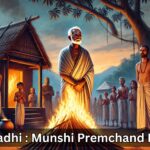“Hawk Roosting,” written by Ted Hughes and included in his 1960 collection “Lupercal,” is a powerful and controversial poem that provides insight into the natural world from the perspective of a hawk. The poem is known for its stark portrayal of raw power, predatory instinct, and the amoral nature of the animal kingdom.
Form and Structure:
- “Hawk Roosting” is written in six regular quatrains, and the consistency in form contrasts with the violent and forceful content of the poem. This structured approach adds to the sense of control and precision that the hawk characterizes.
- The lack of a traditional rhyme scheme echoes the hawk’s untamed and unbridled nature.
Themes and Ideas:
- Nature’s Brutality and Instinct: A central theme of the poem is the brutality inherent in nature. The hawk’s voice in the poem reflects a world governed by instinct and survival, devoid of human moral judgments.
- Power and Control: The hawk in the poem symbolizes power and mastery. Its perspective conveys an attitude of dominance and superiority over nature and everything in its environment.
- Perspective and Relativity: By adopting the hawk’s viewpoint, Hughes explores the idea that morality is relative. The hawk’s monologue challenges human notions of right and wrong, suggesting a different, more primal understanding of the world.
Imagery and Language:
- Hughes employs visceral and striking imagery to depict the hawk and its world. The language is direct and unflinching, mirroring the hawk’s pragmatic view of its existence.
- The imagery used in the poem emphasizes the physicality and presence of the hawk – its hooked beak, closed feet, and sharp eyes – underscoring its predatory nature.
Symbolism and Metaphor:
- The hawk can be seen as a metaphor for different forms of power – natural, political, or existential. Its self-assuredness and sense of pre-eminence might represent a critique of human arrogance and the desire to dominate.
- The poem’s perspective encourages readers to consider the world from an alternative, non-human vantage point, questioning anthropocentric views of nature and existence.
Tone and Mood:
- The tone of “Hawk Roosting” is assertive and confident, reflective of the hawk’s perception of its unchallenged supremacy. There is a cold, detached quality to the hawk’s voice, highlighting its predatory nature.
- The mood of the poem is contemplative yet intense, provoking thought about the fundamental aspects of nature and existence.
Critical Reception:
- “Hawk Roosting” has been subject to various interpretations and critical discussions. Some readers view it as an exploration of nature’s innate cruelty, while others interpret it as a metaphor for human tyranny and authoritarianism.
- The poem is often admired for its bold perspective and Hughes’s skill in capturing the essence of the hawk’s character, offering a stark reflection on power, nature, and the instinct to survive.
The most massive and influential force in English poetry in the 1960 and since is often taken to be Ted Hughes. Within a decade of the publication of his first book. The Hawk in the Rain (1957), he was accepted as the classic of our time. Very large critical claims have been made for Hughes. The poem in the first two books. ‘The Hawk in the Rain and then Lupercal mainly concentrated on physical vividness of a kind that was certainly uniquorable.
The Hughes world was one that was turbulently full of predatory animals. Primitive Violence and moments of extreme human endurance. The present poem is a very good example of about the bird hawk. The bird haws is the symbol of a fascist dictator like Hitler. It is a commentary upon power mania. It is a very short poem in length but powerful in spirit. It tells us how a hawk rest in the nest and what he thinks and plans. His hands and feet are tied together but he is dreaming of killing other birds. That is the symbol of powerful feeling. We get idea from the following passage:
Also Read :
- Compare Hamlet with Macbeth, Othello and other Tragedies
- “The Pardoner’s Tale” is the finest tale of Chaucer
- Prologue to Canterbury Tales – (Short Ques & Ans)
- Confessional Poetry – Definition & meaning
- Line By Line Explanation Of The Poem The Eve of St. Agnes
I sit in the top of the wood, my eyes closed. In action, no falsifying dream
Between my hooked head and hooked feet. Or in sleep rehearse perfect kills and eat.
In the other passage the poet says that the hawk gets the facility of high trees and air’s buoyancy. His feet are locked but it seems that the bird hawk is inspecting the earth.
The poet says that the hawk is free to do anything. He kills whatever he wants. There is one special path of its flight through the bones of the living. Its height is without any arguments, even the sun remain behind it. It does mean that the bird is the symbol of God who is almighty and powerful. All the world is changeable in the mind of the hawk. For the hawk the earth is like a playground where the bird plays. It kills the small creatures or let him alive. In fact the poem is a symbolical poem. The hawk is the symbol of dictator who rules over the world of birds.
Naturalism and Realism:
- Hughes’s approach in “Hawk Roosting” is marked by a stark naturalism. He does not shy away from the more brutal aspects of nature, presenting them as intrinsic and unapologetic elements of the hawk’s existence. This naturalism challenges more romanticized perceptions of nature, offering a raw and realistic portrayal of the animal world.
Anthropomorphism and Its Limits:
- While the poem employs anthropomorphism by giving the hawk a human-like voice, Hughes carefully maintains the hawk’s animalistic perspective. The hawk’s thoughts and expressions are devoid of human moral considerations, reflecting an instinctual and primal worldview. This technique invites readers to reconsider their anthropocentric biases and to recognize the distinct realities of other beings.
Solipsism and Existentialism:
- The hawk’s solipsistic viewpoint, where it sees itself as the center of its universe, raises existential questions. The hawk’s existence is defined solely by its own needs and instincts, presenting a perspective where traditional human concerns and moralities are irrelevant. This viewpoint can be seen as an exploration of existential themes, questioning the nature of existence and consciousness.
Power Dynamics and Autonomy:
- The hawk’s assertion of autonomy and control in its environment reflects broader themes of power and dominance. Hughes effectively uses the hawk as a symbol to explore how power operates in the natural world, free from human ethical constraints.
Symbolic Interpretations:
- “Hawk Roosting” has been subject to various symbolic interpretations. Some view the hawk as a symbol of totalitarian power or as an embodiment of nature’s indifferent strength. Others interpret it as a commentary on the human tendency to project power and dominance over nature and each other.
Stylistic Elements:
- The poem’s stylistic elements, including its straightforward diction and rhythmic flow, complement its themes. The absence of complex metaphors or ornate language aligns with the hawk’s direct and pragmatic view of the world.
Critical Debates:
- The poem has sparked critical debates about its underlying messages. While some appreciate its unvarnished depiction of nature and its thematic depth, others have critiqued it for seemingly glorifying aggression and dominance.
Conclusion:
“Hawk Roosting” is a complex and provocative poem that encapsulates Ted Hughes’s ability to blend raw realism with deep philosophical inquiry. Through the hawk’s perspective, Hughes challenges readers to confront the unembellished realities of the natural world and to question human perceptions of morality, power, and existence. The poem stands out for its bold perspective, its exploration of profound themes, and its contribution to discussions about the relationship between humans, nature, and the animal psyche.











